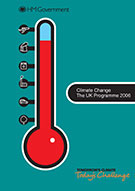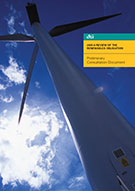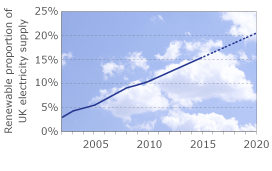

The UK is the world’s 8th largest emitter of greenhouse gasses, responsible for over 4% of the global emissions, and under Kyoto, has committed to reduce its emissions to 12.5% below 1995 levels by 2008/12. Combined with national objectives, this is the major driver for UK Givernment policy in the areas of climate change and renewable energy, the most important elements of which are described below.
UK Climate Change Policy
 The UK's climate change programme was first published in 2000. Amongst other things, this established targets to:
The UK's climate change programme was first published in 2000. Amongst other things, this established targets to:
- Reduce CO2 emissions to 20% below 1990 levels by 2010 (more stringent than the Kyoto); and
- Increase the proportion of electricity generated from renewable sources to 10% by 2010.
The climate change programme was updated in 2006 and, leading on from this, a Climate Change Bill was introduced to Parliament in 2007 which included long-term targets to:
- reduce CO2 emissions to 26-32% below 1990 levels by 2020; and
- to further reduce them to 60% below 1990 levels by 2050.
The Climate Change Bill is expected to receive Royal Assent in summer 2008 and would make the UK the first country in the world to have substantial, legally binding long-range CO2 reduction targets.
UK Energy Policy
 Formal energy policy in the UK was established (for the first time in 20 years) in the 2003 White Paper “Our energy future – creating a low carbon economy”. Amongst other things this policy document:
Formal energy policy in the UK was established (for the first time in 20 years) in the 2003 White Paper “Our energy future – creating a low carbon economy”. Amongst other things this policy document:
- set a target of achieving a 60% cut in CO2 levels by 2050 (now included as a binding obligation in the Climate Change Bill); and
- set an “aspirational target” of extending the renewable electricity target in the 2000 climate Change Programme to 20% by 2020.
The 2003 White Paper did not consider the issue of new nuclear power stations and the need to address this (principally) led to the 2006 Energy Review and in turn the 2007 Energy White Paper "Meeting the energy challenge". Aside from creating a framework for new nuclear build, this White Paper:
- translated the aspirational target for 20% renewable electricity by 2020 into a firm target;
- introduced “banding” of the Renewables Obligation (see below) so as to provide greater support for emerging technologies such as offshore wind and reduced support for more established ones; and
- provided a “statement of need” for renewable energy projects (which local authorities are required to take account of in planning decisions) and made a commitment (through the 2007 White Paper “Planning for a sustainable future”) to streamline the process for appeals and Public Inquiries.
These policies have led to the following specific mechanisms being put in place which, at a practical level (and in conjunction with EU-ETS and LCPD), are the principle drivers for the growth of renewable electricity in the UK.
Renewables Obligation (RO)
 The earliest mechanism for incentivising renewable energy in the UK was the Non-Fossil Fuel Obligation (NFFO). This ran from 1990 until 1998 and awarded renewable energy generators 15 year, fixed price power purchase contracts (many of which are still in place today) on the basis of competitive tenders.
The earliest mechanism for incentivising renewable energy in the UK was the Non-Fossil Fuel Obligation (NFFO). This ran from 1990 until 1998 and awarded renewable energy generators 15 year, fixed price power purchase contracts (many of which are still in place today) on the basis of competitive tenders.
In order to help deliver the more ambitious renewable energy targets set out in the Climate Change Programme, NFFO was replaced by the Renewables Obligation (RO), a new market-based mechanism, in 2002. Under the RO, electricity suppliers are required to source an increasing proportion of the electricity they sell from renewable sources (3% in 2002 rising to 10.4% in 2010) or “buy-out” of this obligation at a cost of ~3.5p/kWh. Any sums electricity suppliers pay to buy-out of their obligations are recycled to those suppliers who fulfil their obligations, so as to further increase the incentive on utilities to source electricity from renewable sources.
 Following a review in late 2003, a new target of achieving 15.4% renewable electricity by 2015 was established which came into force in 2005. A further extension of the target to 20% by 2020 was included in the 2007 Energy White Paper and is expected to enter into law during 2008.
Following a review in late 2003, a new target of achieving 15.4% renewable electricity by 2015 was established which came into force in 2005. A further extension of the target to 20% by 2020 was included in the 2007 Energy White Paper and is expected to enter into law during 2008.
Going forward it is anticipated that, to meet the new (EU-led target) for the UK to achieve 15% renewable energy by 2020, some 35-40 % of electricity will need to come from renewable sources. Further amendments to the Renewables Obligation (or a replacement mechanism) will undoubtedly be required to deliver this.
Climate Change Levy (CCL)
 Introduced in April 2001, the climate change levy works in conjunction with EU-ETS by imposing a tax on the energy use of major commercial, industrial and public sector energy consumers. The aim of the levy is to encourage users to improve energy efficiency and reduce emissions of greenhouse gases.
Introduced in April 2001, the climate change levy works in conjunction with EU-ETS by imposing a tax on the energy use of major commercial, industrial and public sector energy consumers. The aim of the levy is to encourage users to improve energy efficiency and reduce emissions of greenhouse gases.
This tax amounts to ~0.5 p/kWh and is applied by utilities to the electricity they sell to non-domestic consumers (the utilities in turn paying this tax to HMRC). Businesses in particularly energy-intensive sectors (e.g. cement production) are given a reduction of 80% provided they sign up to Climate Change Agreements with specific targets for improving energy efficiency or reducing CO2 emissions
Electricity generated from renewable sources is exempt from the CCL, so giving non-domestic consumers a direct financial incentive to purchase this, and generators an incentive to produce it.
Planning Guidance
In addition to financial measures, national planning guidance has also been specifically developed to recognise the importance of renewable energy and encourage the development of new projects. Principal among the guidance documents are the following:
| Area | Policy | Guidance provided |
|---|---|---|
| England | Planning Policy Statement 22, “Renewable Energy” (2004) | PPS22 seeks to create a “positive planning framework for renewable energy” and in particular requires local authorities to (i) promote and encourage renewable energy schemes in Regional Spatial Strategies (RSS) and Local Development Documents (LDD’s) and (ii) afford significant weight to the wider environmental and economic benefits of renewable energy proposals when determining planning applications. |
| Scotland | Scottish Planning Policy Guidance 6 (2007) | SPPG6 sets out how the planning system (in Scotland) should manage the process of encouraging, approving and implementing renewable energy proposals when (i) preparing development plans and (ii) determining planning applications. SPPG6 works in conjunction with Planning Advice Note 45 (PAN 45) which identifies the planning issues likely to arise with renewable energy proposals and indicates how these can be addressed. |
| Wales | Technical Advice Note 8, “Planning for Renewable Energy” (2005) | TAN8 aims to provide a clear framework for local planning authorities in Wales when making development control decisions. TAN8 differs to English and Scottish guidance by (i) setting specific Welsh renewable energy targets and (ii) identifying 7 strategic search areas in which larger scale on-shore wind proposals should be concentrated. |
In line with this national guidance, Local Plans and Local Development Documents across the UK generally now include renewable energy policies (often containing further criteria specific to the local area) and these can usually be found on district council web-sites. Regional targets and policies for renewable energy have also been developed (in England) and these are set out in Regional Spatial Strategies which are published on regional government web-sites.

